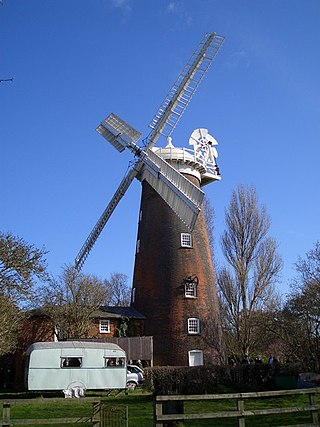
This glossary of mill machinery covers the major pieces of machinery to be found in windmills, watermills and horse mills. It does not cover machinery found in modern factories. [1] [2]

This glossary of mill machinery covers the major pieces of machinery to be found in windmills, watermills and horse mills. It does not cover machinery found in modern factories. [1] [2]













Upminster Windmill is a Grade II* listed smock mill located in Upminster in the London Borough of Havering, England. It was formerly known as Abraham's Mill and was in Essex when built. It has been restored and is a museum open to the public at selected times.

Union Mill is a Grade I listed smock mill in Cranbrook, Kent, England, which has been restored to working order. It is the tallest smock mill in the United Kingdom.

Herne Windmill is a Grade I listed smock mill in Herne, Kent, England, that was built in 1789.

Blackdown Mill or Cherry Clack Mill is a grade II listed smock mill at Punnetts Town, East Sussex, England, which has been restored.

Shiremark Mill, also known as Kingsfold Mill or Capel Mill was a listed Smock mill at Capel, Surrey, England, which was burnt down in 1972.

South Ockendon Windmill was a Smock mill at South Ockendon, Essex, England which collapsed on 2 November 1977.

Stock Windmill is a grade II* listed tower mill at Stock, Essex, which has been restored.

Upthorpe Mill is a Grade II* listed post mill and scheduled monument at Stanton, Suffolk, England, which has been restored to working order.

Buttrum's Mill or Trott's Mill is a Grade II* listed tower mill at Woodbridge, Suffolk, England, which has been restored to working order.

De Berk is a smock mill in Barger-Compascuum, Netherlands. It was built in 1983.

De Bente is a smock mill in Dalen, Netherlands. It was built in 1814. The mill has been restored to full working order. It is listed as a Rijksmonument, number 44563

De Sterrenberg is a smock mill in Nijeveen, Drenthe the Netherlands. It was built in 1977. The mill is listed as a Rijksmonument, number 30957.

De Zwaluw is a smock mill in Burdaard, Friesland, Netherlands which is working commercially. The mill is listed as a Rijksmonument, number 15585.

De Hoop is a smock mill in Norg, Drenthe, the Netherlands. It was built in 1857 and is listed as a Rijksmonument, number 30781.

De Zwaluw is a smock mill in Oudemolen, Drenthe, the Netherlands. It was built in 1837 and is listed as a Rijksmonument, number 38148.

De Ropta is a smock mill north of Metslawier, Friesland, Netherlands which was built in 1840 and is in working order. The mill is listed as a Rijksmonument.

Veldkamps Meuln is a 19th-century tower mill in the village of Bellingwolde in the Netherlands.

De Korenaar is a smock mill in Sexbierum, Friesland, Netherlands which was built in 1868 and is in working order. The mill is listed as a Rijksmonument.

Windlust is a smock mill in Wolvega, Friesland, Netherlands which was built in 1884 and is in working order. The mill is listed as a Rijksmonument.

Johanna, De Korenbloem or De Molen van Schennink is a tower mill in Culemborg, Gelderland, Netherlands which was built in 1888 and has been restored to working order. The mill is listed as a Rijksmonument.